
Brandon Tornero
Designer
For over 150 years, baseball has captured the imagination of players and spectators alike around the world, and the beloved sport is a window into the history and popular culture of the United States. Baseball’s verdant playing fields have shaped the built environment as well: Today, stadiums holding tens of thousands of fans celebrate the National Pastime’s enduring popularity and place in American culture. This year, some of ARG’s Los Angeles and San Francisco staff visited their hometown Major League Baseball ballparks – Dodger Stadium and Oracle Park, respectively – for fun social outings.
The storied rivalry of MLB’s Los Angeles Dodgers and San Francisco Giants has spanned both decades and the continent, from its Nineteenth Century origins as a Brooklyn vs. New York intercity contest, to its present-day SoCal vs. NorCal bragging rights showdown. As part of my lifelong affinity for both architecture and baseball, I would like to share a perspective on how ballparks reflect – and affect – the cities they belong to by comparing ARG’s two “friendly rival” MLB stadiums these franchises call home.
Let’s go on a tour through baseball history, shall we?
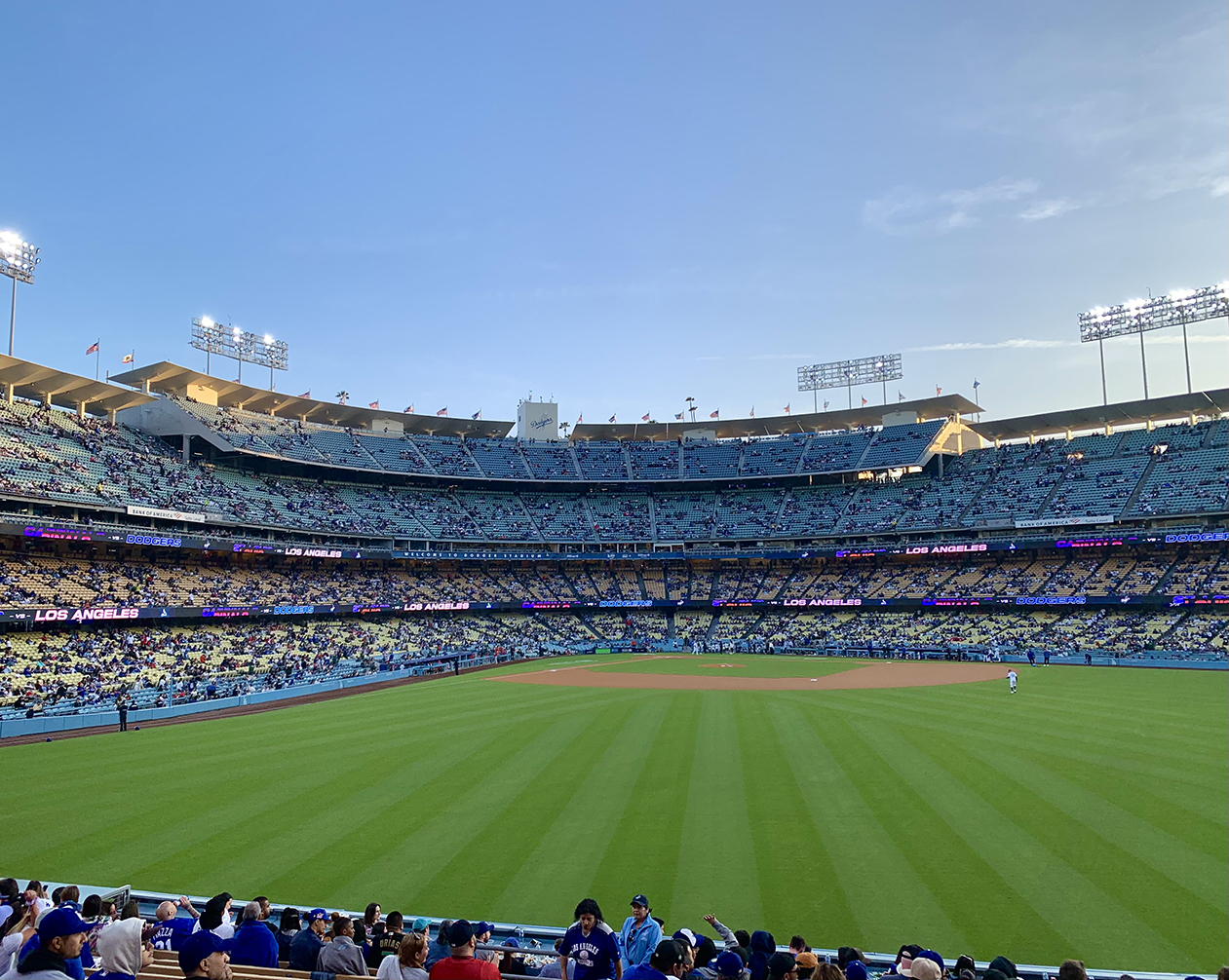
“Dodger Stadium’s immense precast concrete structure is capable of seating 56,000 spectators, making it one of the largest baseball stadiums in the world.” (Photograph by Brandon Tornero, 2023)
Dodger Stadium: Baseball’s Mid-Century Icon
In late June, ARG LA took in a ballgame at Dodger Stadium (1962-present), now the third-oldest ballpark in MLB. While we mingled that evening, I could not help but admire the place that had shaped the memories of so many Angelenos for over six decades.
In 1958, Major League Baseball became a truly coast-to-coast pastime, as the Dodgers relocated from Brooklyn to sunny Los Angeles. At the time, ownership believed that the team had outgrown its venerable home of Ebbets Field (1913-1957), a quaint and charming ballpark in the heart of the borough’s Flatbush neighborhood, and sought to open a cutting-edge new stadium in its place. After negotiations with New York City government (including planning czar Robert Moses) to build a domed stadium in Brooklyn had stalled, team owner Walter O’Malley commissioned architect and civil engineer Emil Praeger to design a new stadium at their new locale in Los Angeles. The result is as awe-inspiring to this day as it was when it opened in 1962: Dodger Stadium’s immense precast concrete structure, with five tiers of cantilevered grandstands and a symmetrical playing field, is capable of seating 56,000 spectators, making it one of the largest baseball stadiums in the world.
In terms of style, the stadium evokes a sense of Space Age technological optimism and a distinct SoCal vibe. The pastel color gradient of soft yellow, orange, turquoise and blue seats evoke the sand and surf of a beach. Two whimsical hexagon-shaped scoreboards make me think of The Jetsons, and angular correlated metal roofs over the outfield pavilions would not be out of place at a chic Palm Springs resort. Recent renovations have accentuated these features, with additional way-finding signage, outdoor plazas, and advertisements designed in this spirit. The indoor-outdoor lifestyle accustomed to Southern Californians is present here as well: Palm trees gently sway beyond the outfield bleachers in the fading twilight, and a little further out, the rolling green hills of Elysian Park flank the San Gabriel Mountains in the distance. In this sublime setting, I felt removed from the frenetic energy of Los Angeles, if only for a few hours. This is baseball paradise.
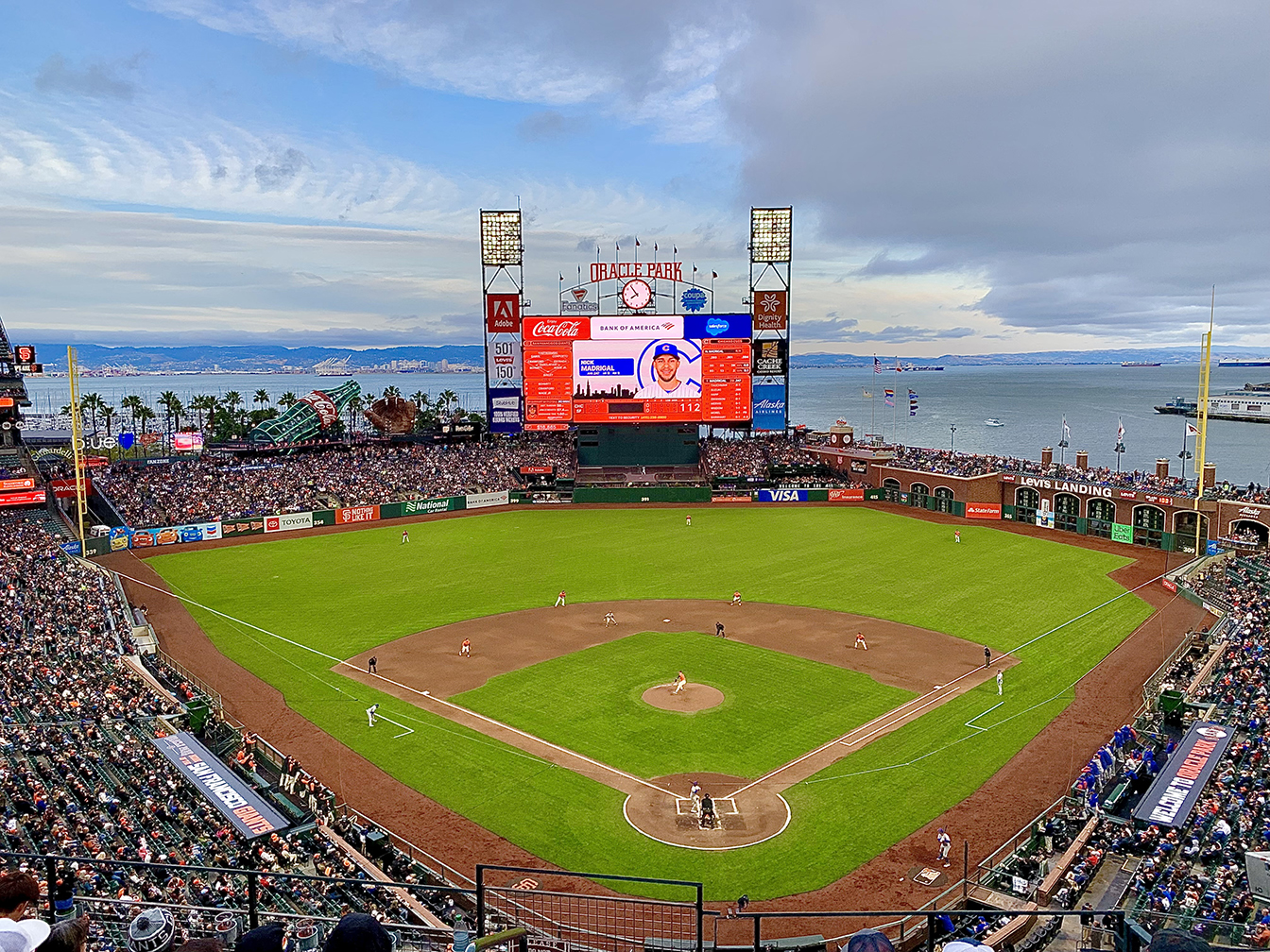
(Overall view of Oracle Park, San Francisco, Photograph by Brandon Tornero, 2023)
Oracle Park: Nostalgia by the Bay
Our next stop is a picturesque point adjacent to San Francisco Bay. I had the opportunity to join a few of my colleagues from the ARG SF office for a Giants game while in town for the 2023 AIA Conference on Architecture in June. The spectacular setting of the Giant’s home ballpark proved to be a remarkable place to socialize as we watched the game.
Even as a life-long Dodger fan, it was hard for me to deny the beauty of Oracle Park (2000-present): It is the epitome of a retro-classic style ballpark, a design movement that swept the sport from the 1990s to the 2010s. Initiated by architect Janet Marie Smith with Oriole Park at Camden Yards (1992-present), retro-classic parks are defined by often asymmetrical playing field dimensions informed by their site, as well as nostalgic references to early Twentieth Century architecture in the urban United States. Designed by Kansas City, MO-based HOK Sport (today known as Populous), Oracle Park’s exposed steel structure, emerald green seats, and brick exterior facade allude to similar design motifs from the “golden age” of baseball, such as Fenway Park (1912-present) in Boston, MA and the original Yankee Stadium (1923-2008) in New York, NY.
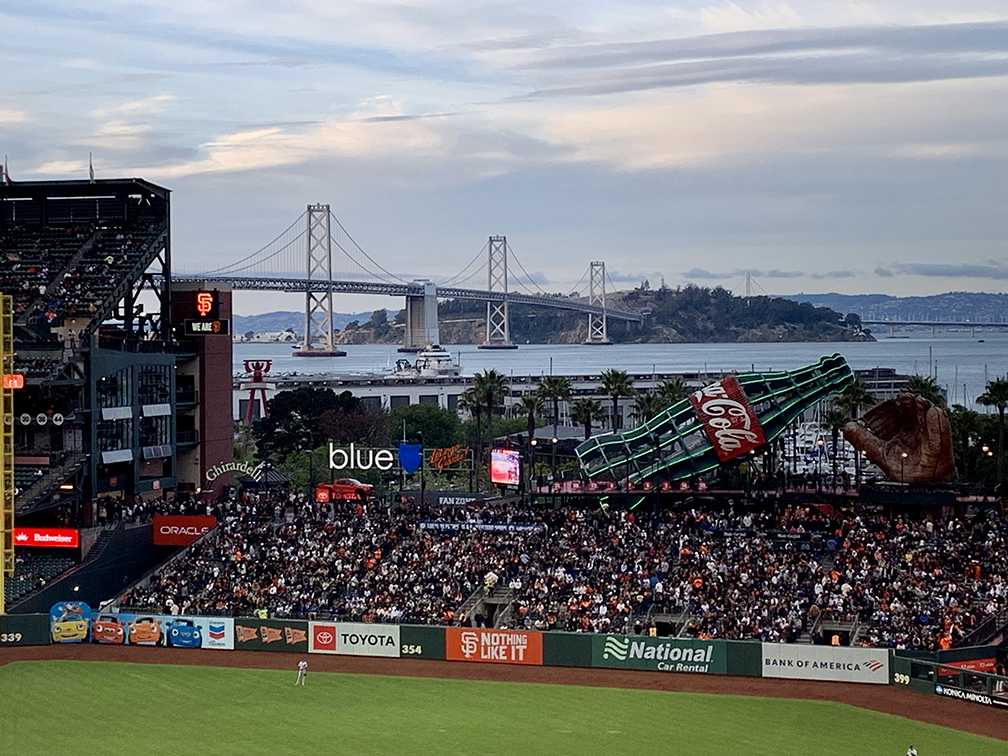
“Even the advertisements present unique experiences for fans: A giant Coca-Cola bottle contains a slide for guests to gleefully slide down.” (Photograph by Brandon Tornero, 2023)
In addition to its construction, the field’s location near China Basin provides for a myriad of unique quirks. Ballplayers can hit “splash landing” home runs into McCovey Cove, which often prompts kayakers to clamor for a souvenir baseball. Outfield walls with oblique angles make baseballs bounce in unpredictable ways. Even the advertisements offer unique experiences for fans: A giant Coca-Cola bottle contains a slide for guests to gleefully slide down. These features rekindle the spirit of early ballpark design, such as a clothier’s advertisement that challenged Dodgers players to “hit sign, win suit” at Ebbets Field. Modern comforts are found here as well: One can enjoy wine and garlic fries in private luxury boxes, and a restaurant called The Garden in center field offers sustainable food options grown on-site. For a game with a history as rich as baseball, this juxtaposition of modern and classic elements seems to be appropriate.
A “Building” Rivalry
The home grounds of the Dodgers and Giants present fascinating contrasts in both style and function, almost as diametrically opposed as the ballclubs themselves. Dodger Stadium’s aesthetic is clearly set in the modernist era in which it was built, while Oracle Park takes design cues from a bygone era. Perhaps the starkest difference I observed during these visits is their means of circulation for guests: The two ballparks reflect changes in circulation design thinking over time, and also mirror the overall urban design of their respective cities.
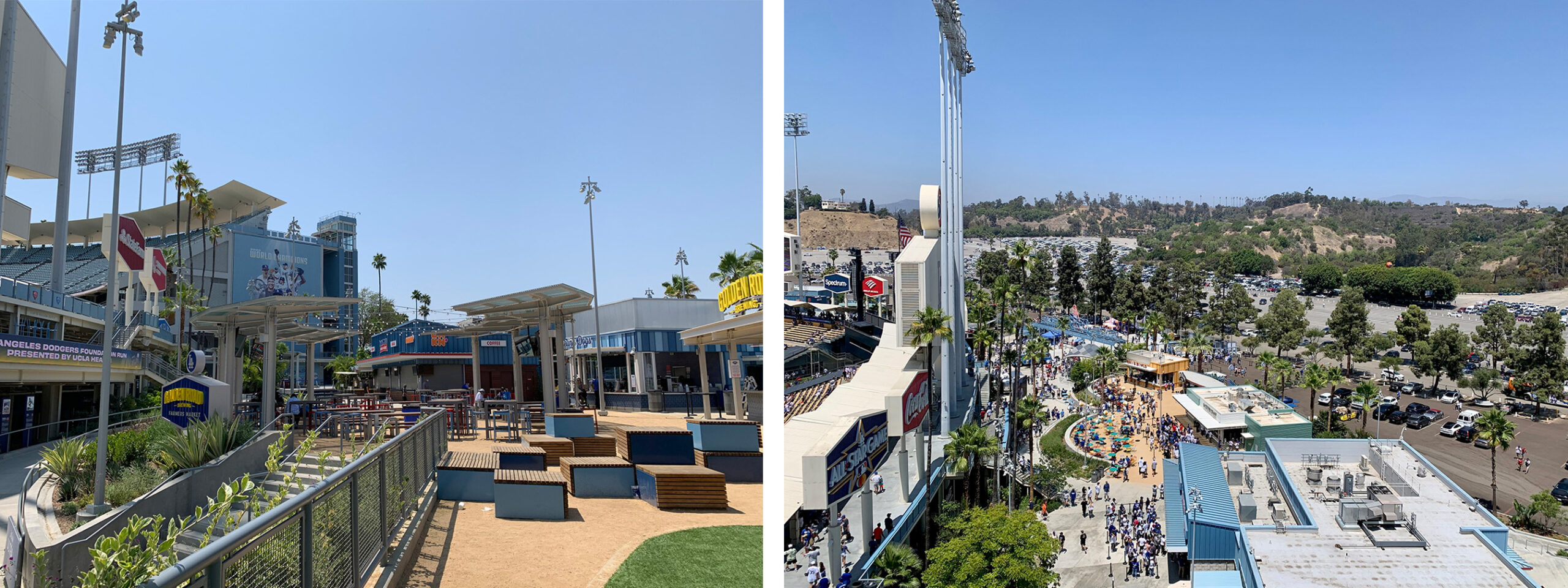
A product of mid-century planning sensibilities, Dodger Stadium’s spacious, symmetrical plan presented a seismic shift in ballpark design when it opened: It is situated in a sea of parking spaces, instead of a dense urban fabric like many of the parks that proceeded it. Unlike its predecessor Ebbets Field, with a footprint shaped by the city streets surrounding it, the stadium’s context is the site of a tragically erased history. The predominantly Mexican-American community of Chavez Ravine once located here was demolished for public housing that was never built. The stadium is built into the remaining hill, akin to ancient Greek amphitheaters or the nearby Hollywood Bowl, with a minimal exterior. Landscaped parking lots, terraced to allow fans to enter the park at grade on each seating level (from the Field Level all the way to the Top Deck), provide rapid access to their cars at the end of the game. Additional plazas, escalators, and elevators included in subsequent renovations have made the park more pedestrian-friendly, but the emphatically automobile-focused design persists as an example of peak car culture from 1960s Los Angeles.
In contrast, Oracle Park is unmistakably tied to its context: In addition to its bayside backdrop, the footprint of the stadium is shaped by King Street to the Northwest, 2nd Street to the Northeast, McCovey Cove to the Southeast, and 3rd Street to the Southwest. It’s street-facing, freestanding structure allows fans to easily arrive to the game on foot or via one of San Francisco’s plethora of public transportation options. Multiple transit lines run conveniently close to the ballpark, including a San Francisco Municipal Railway station just outside the park on King Street. Essentially, each stadiums’ circulation patterns, along with their design features, offer distinct fan experiences that mimic everyday commutes in their home cities.
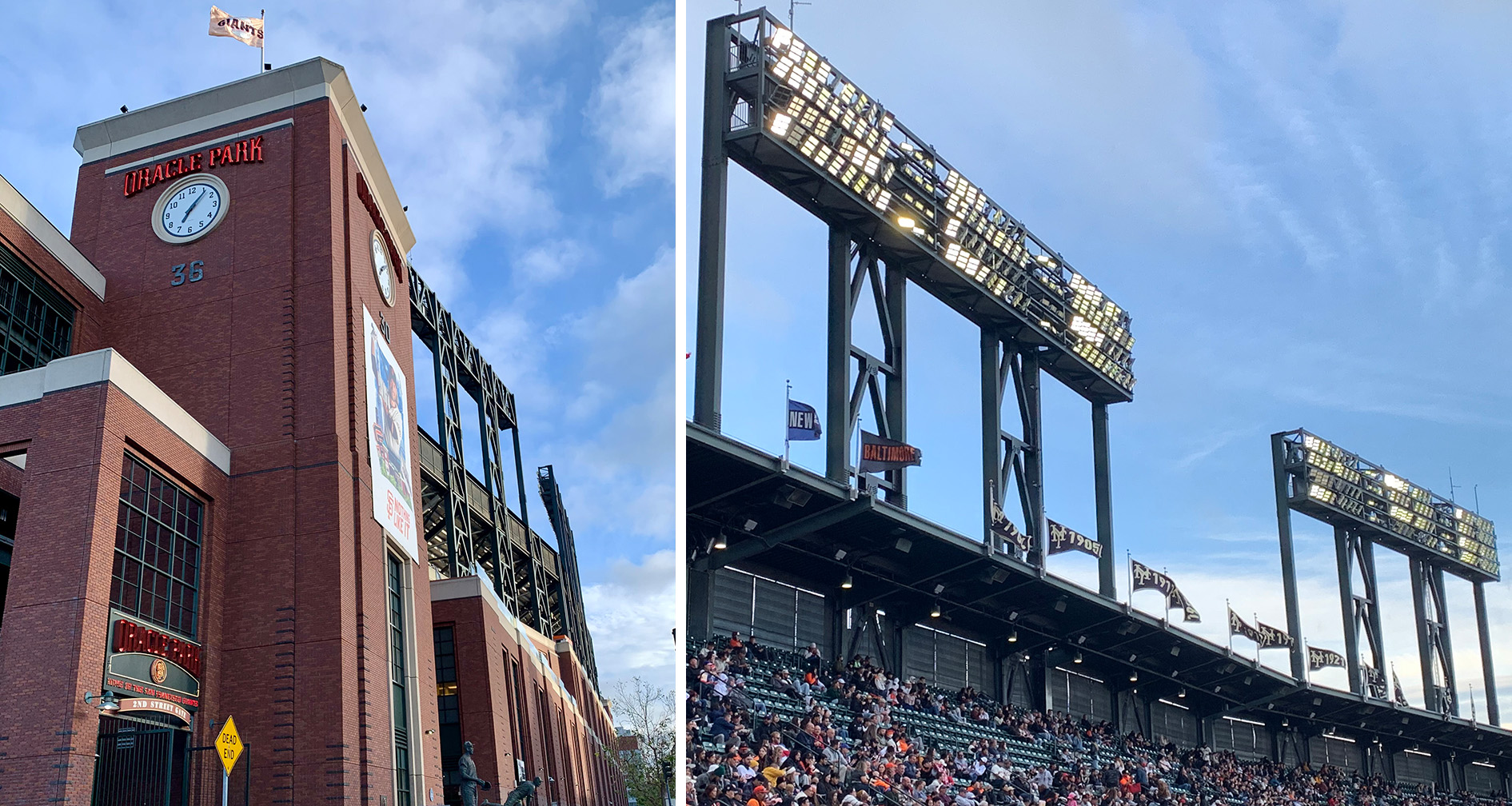
Ballparks: A Collective Storytelling Monumental Architecture
For all of their architectural differences, I believe that both of these ballparks (and spectator sport venues as a building type at large) share two important traits: Their role as engines of community socialization and as pillars of collective memory.
Sports are often one of the easiest ways for strangers to engage in conversation, and geographically-based fandom can help new acquaintances quickly learn of their hometowns. In my personal experience, wearing a blue LA cap on the street (and especially while traveling outside of California) often elicits lively discussion (and sometimes shouts of “Let’s go Dodgers!”). This place-based camaraderie is amplified upon entering the turnstiles of a ballpark. People from all walks of life, from lifelong residents to wide-eyed tourists, can assemble at a singular gathering place for the common purpose of cheering on one of the two competing teams. Family, friends, and even strangers who have never met can instantly form a bond when watching the game together, and sudden bursts of on-field action provide excellent ice-breakers. It is an exhilarating feeling like no other when thousands of human beings respond to a towering home run or a dramatic catch in unison, with a roar that resonates throughout the ballpark (a feeling I certainly experienced alongside my colleagues during our outings). Baseball traditions such as singing “Take Me Out to the Ballgame” during the “7th Inning Stretch” and group chants led by a live organist amplify this atmosphere.
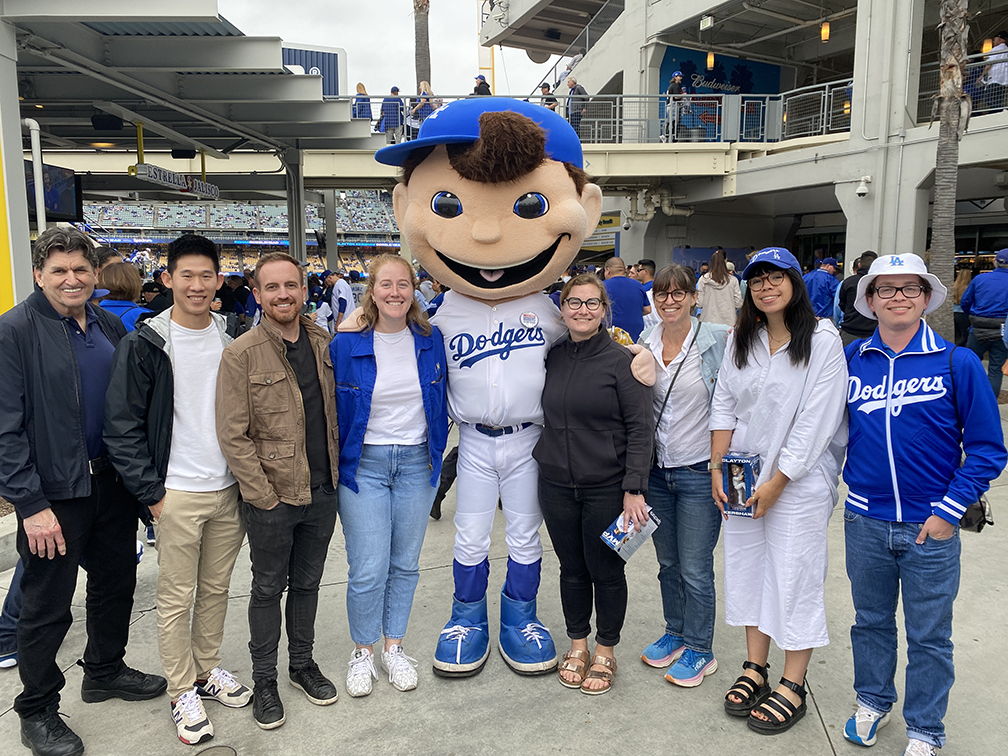
ARG LA staff soaking in Dodger stadium.
Over time, these shared moments of camaraderie compound to build a collective narrative that spans the existence of the ballpark. The surroundings of a stadium often conjure up stories of past baseball glories – and the older the park, the richer the tales – especially when conversing with seasoned fans. The leisurely pace of a baseball game lends itself to casual conversation, and provides ample opportunity to swap stories and to get to know your seat-mates better for a few hours. When I started regularly attending ballgames as an 8-year-old, my family shared memories of games they witnessed as children on the very field that was right before my awe-struck eyes. As such, I feel an intangible connection to my parents’ childhood whenever I visit Dodger Stadium: It is neat to know that I have watched Clayton Kershaw pitch on the same field that my grandparents took my parents to see players like Sandy Koufax play on decades ago.
While each ballpark has its own unique quirks, several common design features encourage these moments of social interaction and storytelling to occur organically. Thousands of fixed seats placed only inches apart make conversation with others almost inevitable. In addition, recent trends such as open-air concourses that connect multiple seating areas and non-ticketed standing rails located throughout stadiums have embraced the tendency of fans to wander from their seats and explore the ballpark between innings (foraging for food, souvenirs, and if they’re lucky perhaps an autograph from their favorite player). Serendipitous encounters are bound to happen with so many people crossing paths. In an era of increasing social isolation, it is important that places like ballparks are maintained to stimulate social interaction and provide unifying experiences to both meet new friends and strengthen kinship alike.
I hope you enjoyed this travelogue of ARG’s hometown ballparks. From baseball’s origins as a respite away the hustle and bustle of urban life during the Industrial Revolution to the present day, this pastoral game continues to provide an escape for millions of fans each year. My ongoing travels have taught me that no ballpark is the same, and each offers a small slice of the character of its home city. Each park has a story that deepens with time: Dodger Stadium will always win over my heart due to the personal connection and cyclical pilgrimages, year after year. And yet, I recognize the beauty of Oracle Park and relish in the opportunity to discover distinctive traits at every ballpark I visit. At their best, I believe they also create an intangible sense of community and support shared experiences that span generations. Time may move ever forward, yet the old ballgame remains timeless.
